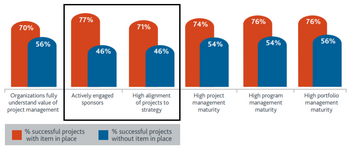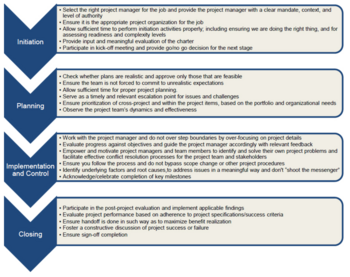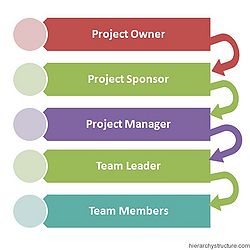Project sponsor
(→Relationship with other Stakeholders) |
(→Relationship with other Stakeholders) |
||
| Line 66: | Line 66: | ||
Some missions depend on the advancement of the project, and some must be realized regularly, with the project manager and the project team. | Some missions depend on the advancement of the project, and some must be realized regularly, with the project manager and the project team. | ||
"The Sponsor versus the Project Manager" is a leitmotiv in project management, but it shouldn't be so, they have complementary tasks and should work hand by hand to carry the project until the end with the best results.}} | "The Sponsor versus the Project Manager" is a leitmotiv in project management, but it shouldn't be so, they have complementary tasks and should work hand by hand to carry the project until the end with the best results.}} | ||
| − | + | </noinclude> | |
==Good practices== | ==Good practices== | ||
It is a good idea to keep in mind the fact that there might be more than one project sponsor, depending on the size of the project for example. | It is a good idea to keep in mind the fact that there might be more than one project sponsor, depending on the size of the project for example. | ||
Revision as of 16:16, 19 February 2018
This wiki-article is written in order to reflect on how important the role of Project Sponsor (also called executive sponsor) is in a project, and actually is the backbone for the entire project, and without whom the project would not be started. This role is often skipped or misdefined, which can explain why some projects are failing, or not doing as good as they should. To improve global understanding about Project sponsorship, we will present the role and definition of what is a Project Sponsor, what are his responsibilities throughout the project (focusing on the initiating phase), then describe the relationships with the other stakeholders of the project and then finish with some advice to avoid most common pitfalls.
Sponsors play an essential, if not vital, role in projects, and even though some people may disagree, every project needs a project sponsor. Sponsorship in a small business is, however, often significantly different from sponsorship in a large business or a corporation. Because the roles and responsibilities of a sponsor and a project manager run parallel but are different from each other, it is important to know both what project sponsorship is and what it is not (this will be discussed later in the section "Relationship with the stakeholders"). A powerful quote supporting this insight was given by a senior project manager "I now understand that a project I recently sponsored was not nearly as successful as it could have been—partly due to my not having understood my role as a sponsor." [1] Despite the lack of formalization of the position in a project, we will rely on the information given by organisations linked to project management, such as the PMI (Project Management Institute)[2] and their conferences[3]. or their book Project Management Body of Knowledge (PMBoK) or the IPMA (International Project Management Association)[4]. . As this topic is related to project management, we will also use the PRINCE2 as a reference. Managing stakeholder expectations for project success [5]
Effective PM (Project Manager) and BA (Business Analyst) role collaboration [6]
Project sponsorship—Senior management's role in the successful management of projects [7] Another reliable source of information that we will use, is the KPMG report published every year, that presents surveys and research about project management in general and sometimes about Project Sponsor. [8]
Contents |
Definition and Role of the Project Sponsor
Definition
A Project Sponsor is: " An individual (often a manager or executive) with overall accountability for the project." (definition is given during PMI Global Congress in London in 2015) [1] . This vision is stated again in The PRINCE2, where the term for Project Sponsor is Executive ref. There are many pressures to contend with, especially at the higher levels of management and multiple priorities and causes compete for scarce organizational resources, capacity, funding, and focus. A project Sponsor is not a Project manager nor the Project Owner (also called "benefit owner"). These three jobs have different tasks and responsibilities and for the good of the project, they should clearly be differentiated. The most common distinction is that the sponsor wants the project implemented and will pay for it and the owner is the person who will benefit from the realization of the project. The Project Manager is the one that will implement what the Project Sponsor has decided to do. MOre information will be given in the section "relation with other stakeholders". It can be mentioned that unlike a large business, in which a sponsor can be any one of a number of different individuals, in a small business, the sponsor is most often the business owner. to be developed.
In brief, it is the individual or group within the performing organization who provides the financial resources, in cash or in kind, for the project. [9] It needs to be clarified that the project sponsor is not the customer nor the client, but someone from the performing organization that understands the organization's business and the corporate strategy. Project sponsors are often senior or former project managers, that have experience about project management and have a deep understanding of the project.
Role

The role of the Sponsor starts at the very origin of the project. They play a crucial role in the development of the initial scope and charter, and effective sponsors lead the project through the selection process until formal authorization. The first duty of the Project Sponsor is to define the project, identifying what the project must achieve. This requires a good understanding of how the organization operates and the corporate strategy. Once the project’s organizational goals are defined, the Sponsor must translate that vision into clearly understood deliverables for the Project Manager and team.[8] Another mission, is to choose the project sponsor. This mission is not globally accepted. We put here the result of a survey from 2015 that shows that project with a highly engaged Project Sponsor succeed around 77% of the time while for the other it's only 46 %, the alignment of the project with the strategy has a huge impact as well: [10]. The Project SPonsor is the escalating path for the Project Manager to the top management and from that perspective its upper hierarchy. (check for relevance in this article: Project governance is an “oversight function that is aligned with the organization's governance model and encompasses the project life cycle,” according to A Guide to the Project Management Body of Knowledge (PMBOK® Guide) – Fifth Edition (Project Management Institute, 2013, p. 34))[9]
Responsibilities
A project sponsor is typically responsible for initiating, ensuring, approving, and establishing a series of key aspects in relation to the project, which can be summed up under categories of vision, governance, and value/benefits realization. The Sponsor must translate that vision into clearly understood deliverables for the Project Manager and team. The stakeholders might have different points of view and different interests in the project, so project sponsors must be the ones to secure buy-in from every stakeholder, in making everyone agree on the project characteristics, sometimes negotiating, but always putting forward how much a better place the world will be after the project is finished. The missions throughout the project are clarified in the picture on the right. Indeed, the span of the responsibilities of the Project Sponsor starts from the initiation of the project to its planning, through its implementation and control until its closing.

The next missions are independent of the stage of the project and must be carried out during its entire length.
✓ Help streamline communication and encourage quality requirements and estimates.
✓ Create a sense of trust, collaboration, and honesty.
✓ Clear role in problem escalation and resource issues.
✓ Means and sources to identify problems (i.e., schedule, cost, quality) before they are officially reported.
✓ Foster requirements and scope prioritization.
✓ Ensure timely change control and decision making; dependency identification mechanism.
✓ Allow for effective risk management process including requirements, project, and business risk considerations.
✓ Encourage record keeping and access to historical information, benchmarking, references, and application of lessons. to be developed
Relationship with other Stakeholders

Cite error:
<ref> tags exist, but no <references/> tag was found